Are you looking for some of the best flowers to plant in your garden in Wisconsin? Situated within USDA hardiness zones 3-5, the Badger State offers a unique climate that accommodates a variety of beautiful flowers.
From robust perennials that can endure cold winters to the brilliance of annuals that come alive in the summer, the options for your gardens are plentiful. So, get ready to add a dash of color to your Wisconsin home as we embark on a journey to discover the finest blooms the state has to offer.
1. Pacific Anemone
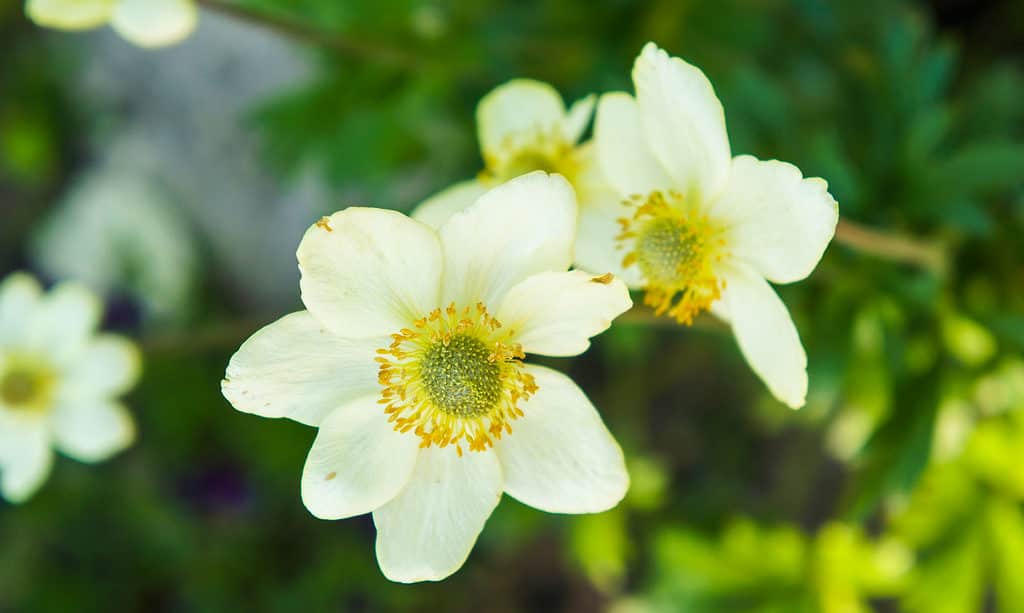
The Pacific anemone is a gorgeous perennial flower that thrives in Wisconsin.
©iStock.com/skymoon13
First on the list is the Pacific anemone, a perennial that is easy to grow and naturally occurs in clusters. These clusters consist of slender stems, each covered with delicately divided, fluffy leaves and long stalks. From late spring to the end of summer, this plant displays individual, silky flowers with a poppy-like appearance.
These blossoms measure about an inch across, exhibiting green, yellow, or purple hues on the outer petals, with a soft yellowish-white color on the inside. They bloom for a number of weeks, creating a lovely display atop the stems.
As a lover of partial shade, this flower flourishes best in moist, well-draining soils enriched with gravel and lime. Sow its seeds during the fall or the start of spring for best results. If you’re dealing with an older plant, it can be split up during the spring to promote more growth.
2. Canadian Columbine
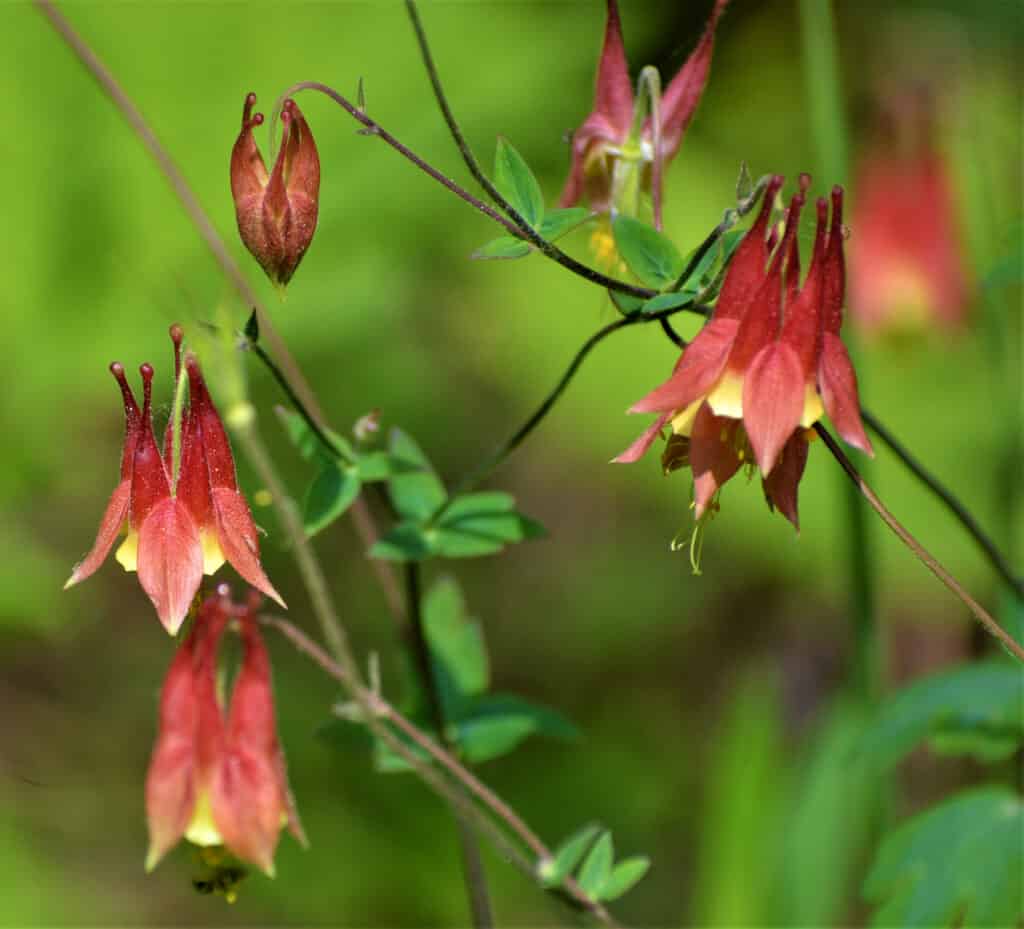
This is a beautiful flower that blooms very easily in cold climates, making it perfect for Wisconsin!
©akslocum/Shutterstock.com
Canadian columbine, a distinguished flower, originates from the woodlands and rocky inclines of eastern North America. It stands out for its hanging flowers, which measure between 1-2 inches wide and have an extended, spur-like shape. The blossoms have bright red sepals, light yellow petals, and clustered yellow stamens.
This perennial blooms from the later part of spring to the early weeks of summer, bringing a delightful splash of color to the shady areas of the garden.
Ideally, it should be grown in conditions ranging from full sun to partial shade. Additionally, this flower thrives in medium moisture, well-draining soils of average quality. Avoid soils that don’t drain well, as it’s not the kind of environment this flower appreciates. As for propagation, you can grow it from seeds sown directly into the garden in springtime, but only once there’s no risk of frost.
3. Dragon’s Mouth
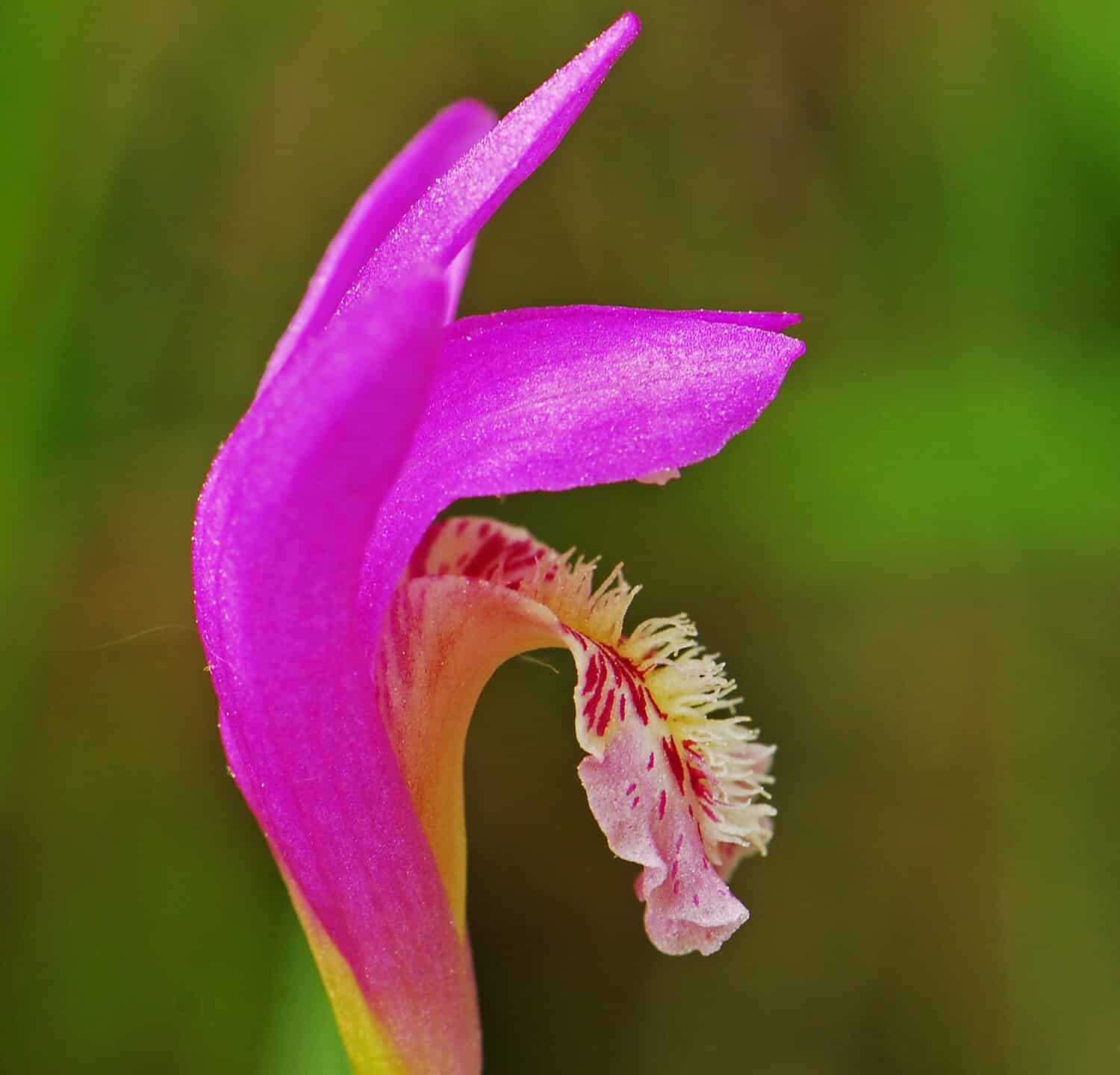
the dragon’s mouth orchid is relatively rare but a highly sought-after, cold-weather flower for gardening enthusiasts.
©Nancy Bauer/Shutterstock.com
Another amazing flower to plant in Wisconsin is dragon’s mouth, a beloved orchid among gardening enthusiasts. This ground-growing orchid features a single, bright pink flower, three upright, solid pink sepals, and two petals that form a protective cover over the lower lip of the flower. The lip of the flower is notably decorative, showcasing a pinkish-white hue with a sprinkling of purple spots and a yellow center line. The lip extends outward and then drops down, adorned with robust bristles that range in color from white to yellow. This flower blooms from the latter part of spring to late summer.
While the flower’s appearance and aroma are captivating, it provides little or no nectar to its pollinators.
The dragon’s mouth orchid thrives in full sunlight to mild shade and prefers acidic, sandy, or loamy, damp soils. For optimal growth, it is usually best to plant orchids in the warmer and more humid seasons of spring or summer.
4. Butterfly Weed
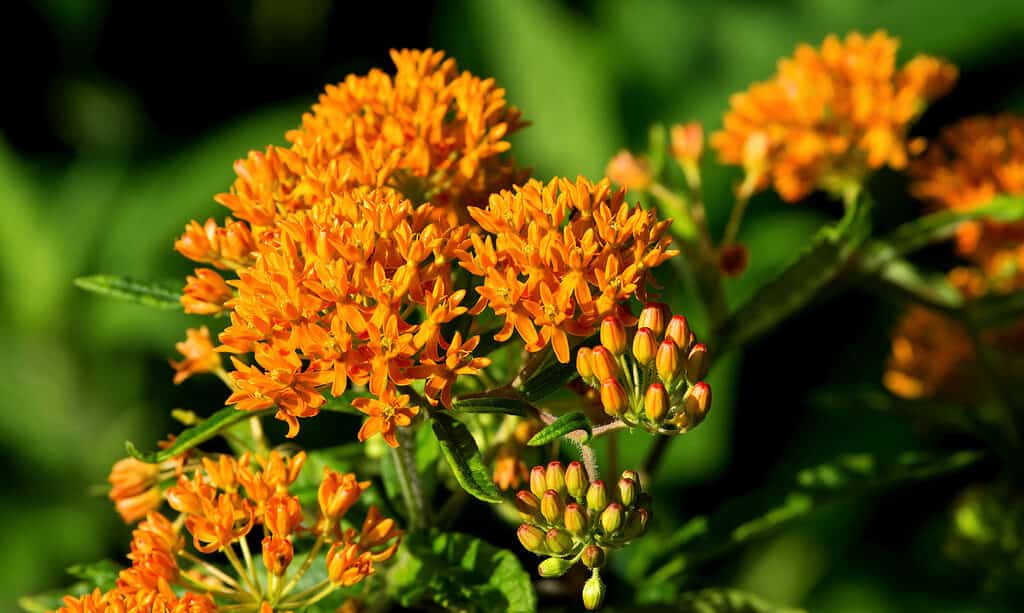
This gorgeous clustered orange flowering plant is called butterfly weed.
©iStock.com/McKinneMike
The butterfly weed is a dense perennial plant celebrated for its clusters of orange to yellow-orange flowers. These blossoms bring a splash of color throughout the summer months. Its profuse, dark-green leaves beautifully contrast the joyful, flat, umbrella-like flowers.
The flowers of the butterfly weed serve as a generous source of nectar for bees, butterflies, and hummingbirds, adding more life and color to your garden.
This plant thrives in full sun, preferring average, dry to medium moisture, well-draining soils. It’s also quite resilient, able to do well in less fertile, dry soils. The optimal time to plant butterfly weed is in the fall or spring.
5. Bushy Aster
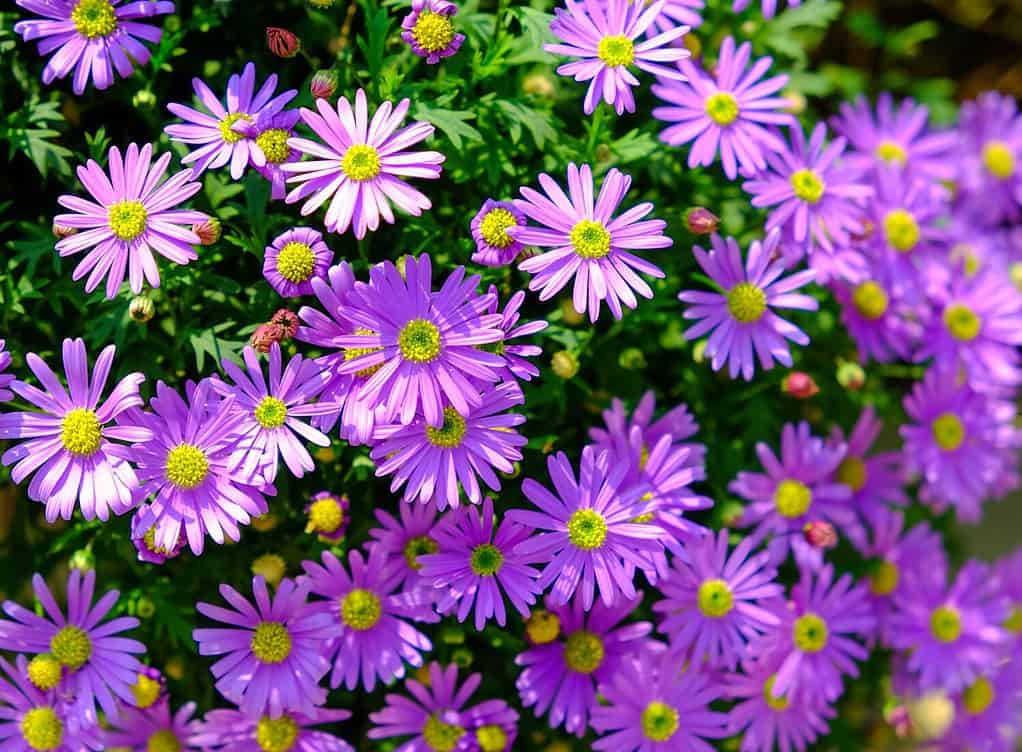
If you are looking to add a splash of purple color to your Wisconsin flower garden, bushy aster is a perfect choice.
©Linhsiaowei/Shutterstock.com
Bushy aster thrives in the slightly warmer regions of Wisconsin and adds a vibrant touch to your garden in the later part of the year with its clusters of star-like flowers. This perennial is rather compact and short, making it perfect for the front of your garden. Notably, unlike many of its aster relatives, this plant stays upright without needing support.
Originally from North America, this plant is easy to care for and durable. Bushy aster also brings a joyful burst of color during the fall. Moreover, it serves as an excellent nectar source for butterflies. This flower blooms for several weeks, from late summer to the end of fall.
The bushy aster prefers full sun to partial shade, thriving in average, dry to moist soils with good drainage. The best time to plant this flower is in late spring or early autumn.
6. Tickseed Sunflower

While not a true sunflower variety, the tickseed sunflower is a beautiful and bright flower to grow in Wisconsin.
©Dinesh Dilip Panchal/Shutterstock.com
The tickseed sunflower is a quickly sprouting annual or biennial plant that showcases many radiant yellow daisies, reaching up to 2 inches across. These eye-catching flowers bloom on long, upright stalks from the middle to the latter part of the summer. Each large bloom is composed of 6-8 vibrant yellow ray florets that encircle yellow disc flowers at their core.
The tickseed sunflower is perfect for adding a natural touch to prairie or meadow landscapes or even the periphery of a woodland area.
This plant thrives in full sun and well-draining, moist soils. It can also withstand partial shade and damp soil conditions. The most suitable time to plant the tickseed sunflower is from spring to early fall.
7. Giant Marsh Marigold
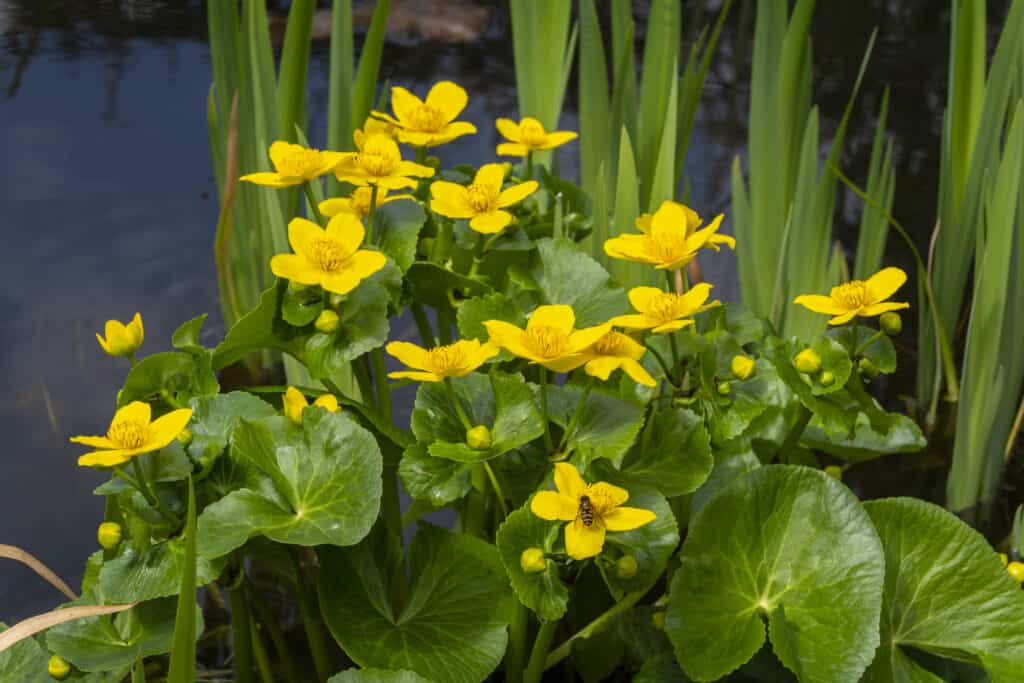
A perfect water flower to grow in Wisconsin is the giant marsh marigold.
©iStock.com/senatorek
The giant marsh marigold, a perennial herb, is treasured for its clusters of large, dazzling golden flowers that can reach up to 2 inches in size. These blooms look like enormous buttercups. Each flower contains up to 40 striking stamens at its center, adding to its visual appeal. This plant displays its radiant flowers from the beginning of spring through the summer.
Serving as a herald of spring, the giant marsh marigold is among the first to blossom in Wisconsin, starting off the growth season with its showy flowers.
This plant flourishes in full sun, preferring deep, nutrient-rich organic soil. It does particularly well at the edge of water bodies or in shallow water up to 6 inches deep. The seeds should be sown in late fall or at the onset of spring for optimal growth.
8. American Basketflower
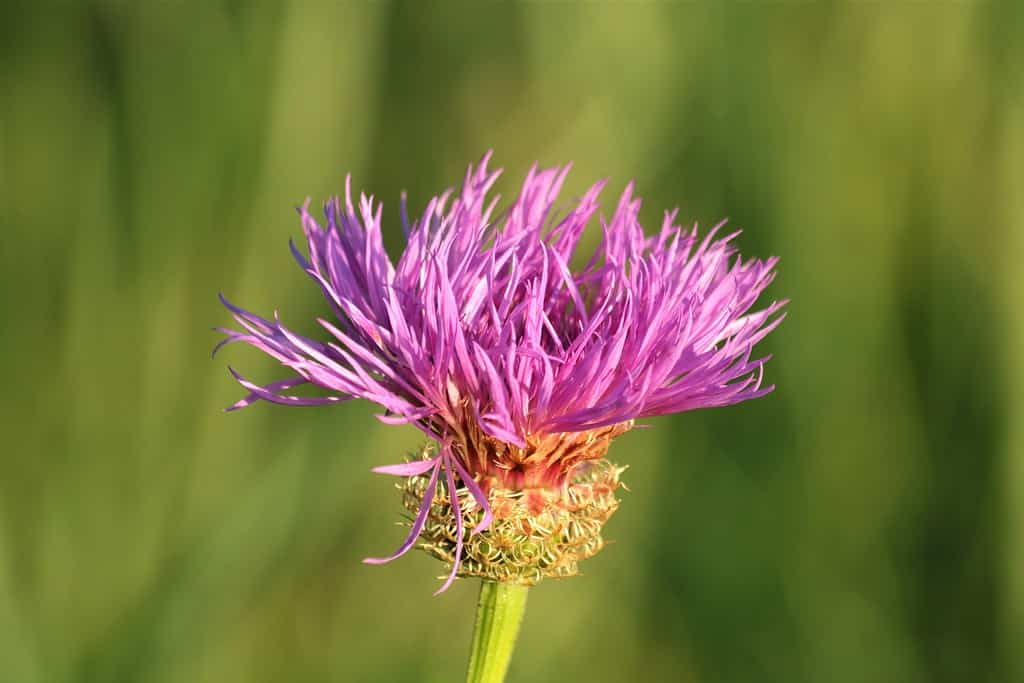
An annual flower with a bright color and unique appearance is the American basket flower.
The American basket flower has a delightful honey-like scent and is a remarkable annual flower that thrives in Wisconsin. Each large flower of the American basket flower spans 4-5 inches across and features pinkish-lavender outer petals encircling a creamy core of disc flowers.
These flowers bloom abundantly from late spring to late summer.
This plant thrives in full sunlight, prefers slightly acidic to neutral soils, and can handle dry to medium moisture levels as long as the soil drains well. This plant is also quite resilient, capable of withstanding drought conditions once it’s well-established. For the best results, start planting in the spring season.
9. Blue-Eyed Mary
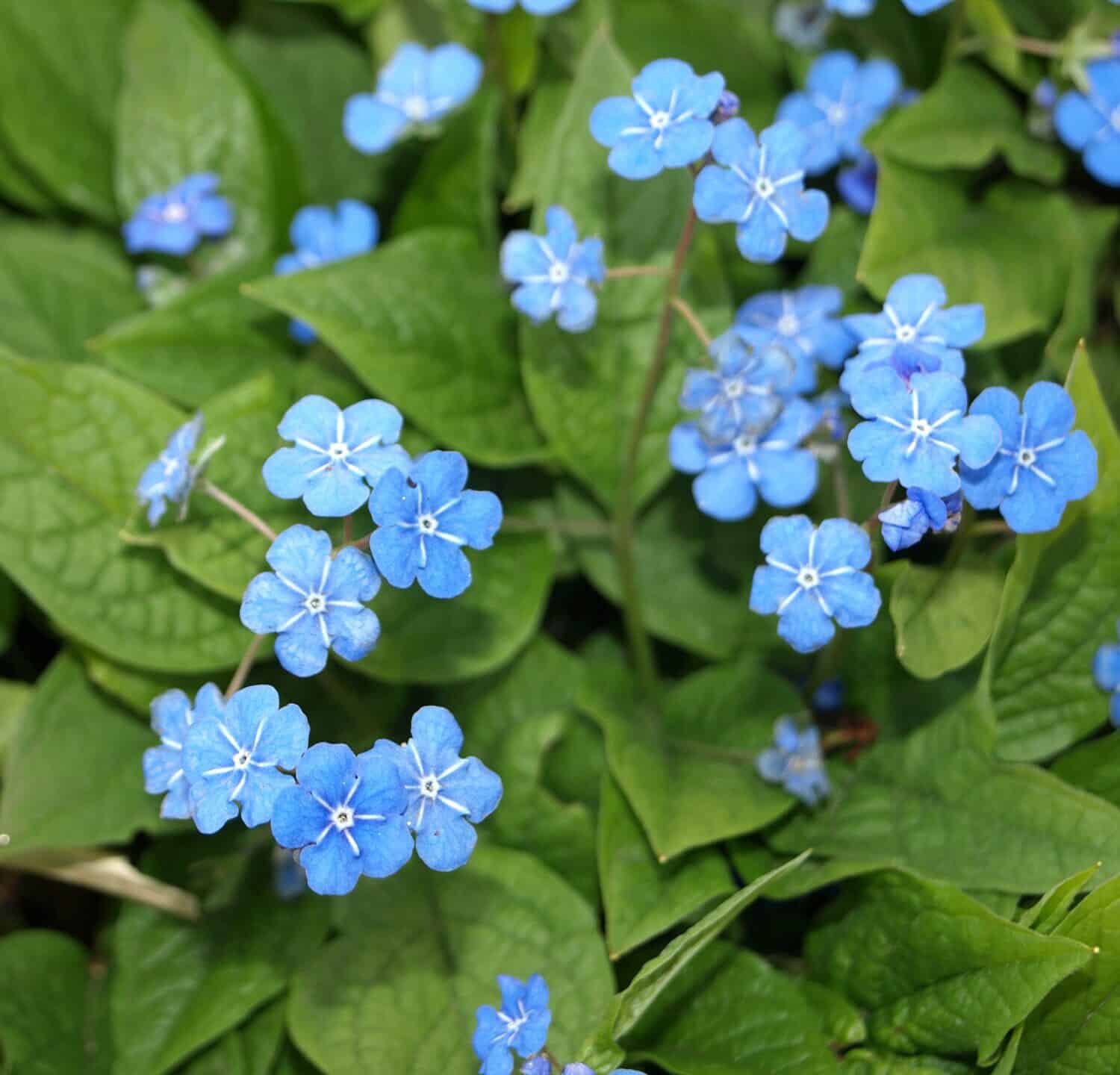
This spring flower adds a touch of bright blue color to your Wisconsin garden.
©lis_wilks/Shutterstock.com
Blue-eyed Mary is a stunning wildflower with a subtle fragrance featuring two-lipped, blue, and white flowers on slim stalks. The flowers bloom from mid-spring until early summer. This plant propagates by self-seeding, often forming colonies of varying sizes.
In certain conditions, blue-eyed Mary can be so abundant that it creates a beautiful, blue carpet-like effect in a landscape. Its flowers offer nectar and pollen that lure bumblebees, honeybees, butterflies, and skippers.
This plant flourishes in partial shade with rich, moist, and well-drained soils. To ensure successful germination, the seeds should be sown during the summer season, allowing them to sprout in the fall.
10. Slender Dayflower
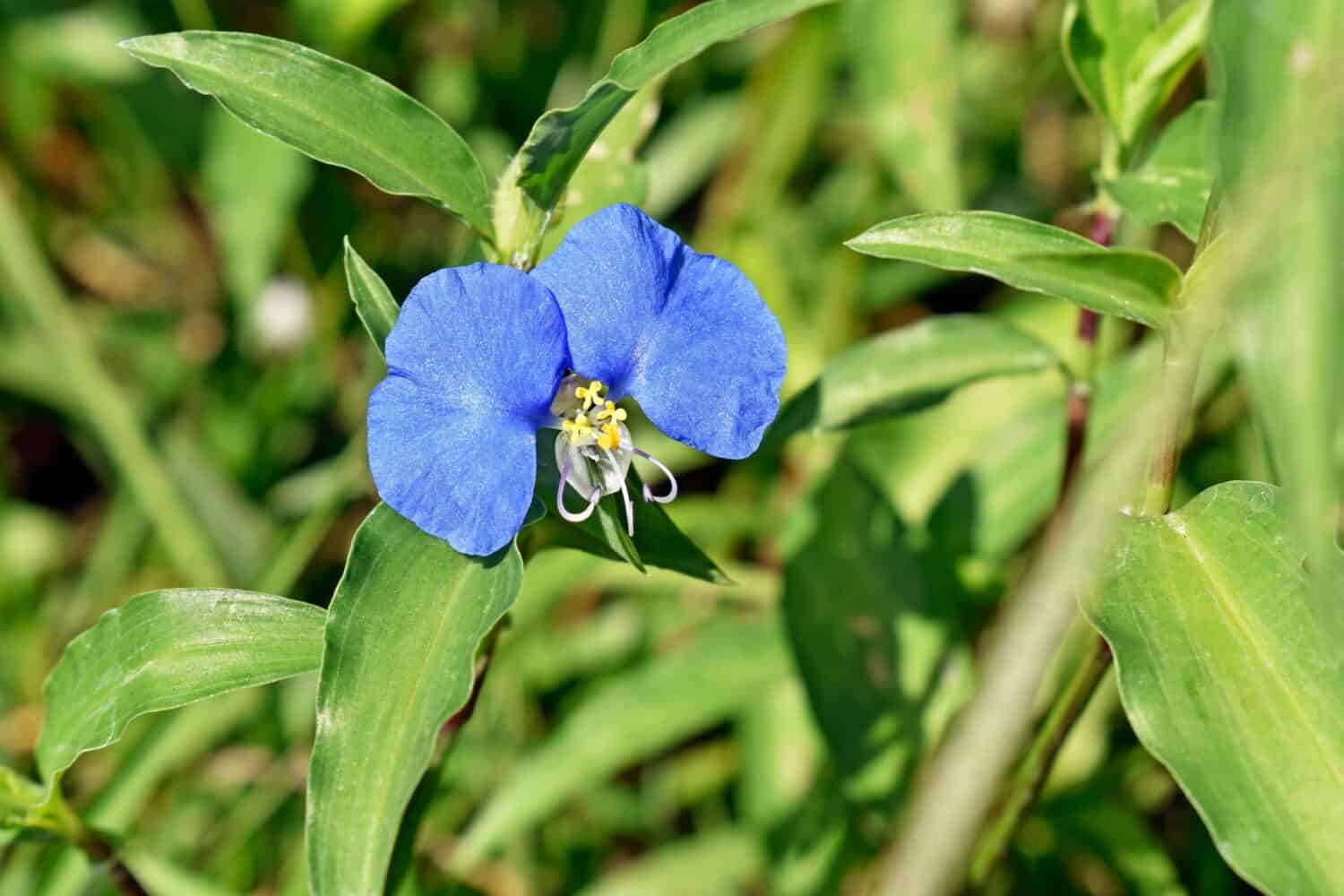
This blue wildflower is a common sight in Wisconsin throughout the spring, summer, and early fall.
©Wagner Campelo/Shutterstock.com
The slender dayflower, native to Wisconsin, is a robust perennial flower featuring erect or upward-leaning stems, which often branch out. The stems are covered with widely spaced, bright green, lance-shaped leaves that range from 2-6 inches long. From late spring to fall, the flower boasts striking bright blue flowers that measure about an inch across. These flowers, each with two large blue, ear-like petals, a smaller white petal, and yellow-tipped stamens, bloom in small clusters for approximately two months.
Both the flowers and the foliage of the slender dayflower are decorative, with the vivid blue hue of the upper petals being a rare sight among wildflowers.
This plant thrives in fertile, sandy or rocky, dry to moderately moist, well-draining soils. It prefers full sun to partial shade. The best time to plant the varieties of dayflower is from late spring to early summer.
11. Prairie Shooting Star

This unique flower is a sight to behold in late spring in Wisconsin flower beds.
©Kristine Rad/Shutterstock.com
The prairie shooting star is a popular perennial wildflower in Wisconsin that features large clusters of 8-20 drooping flowers, each an inch long. The flowers, resembling Cyclamen blooms, can be white, light pink, or rosy pink. Each bloom is characterized by five backward-curling petals and a cluster of prominent yellow stamens that look like umbrellas caught in a gust of wind.
After fertilization, these flowers uniquely turn upwards. The prairie shooting star blooms for about a month in late spring. It’s a recipient of the prestigious Award of Garden Merit from the Royal Horticultural Society.
This plant thrives in partial shade and requires humus-rich, moist, well-drained soil. It’s best to plant the Shooting Star after the last frost in spring.
12. Purple Coneflower

A common flower throughout much of the United States, purple coneflower adds a nice bright pinkish-purple color to your garden.
©Emily Goodwin/Shutterstock.com
The purple coneflower is a favorite among flower lovers in Wisconsin, celebrated for its multitude of large, daisy-like purple blooms that measure around 5 inches across. The vibrant flowers, lasting throughout the summer, sit atop sturdy, upright stems that are adorned with rough, lance-shaped, dark green leaves. Each flower comprises purple petals that droop downwards, encircling a prickly, dark brown cone at the center.
Notably, these flowers are also known for their medicinal uses; they’re commonly brewed into an herbal tea believed to boost the immune system.
This plant flourishes in full sunlight and prefers average, dry to medium-moisture, well-drained soils. It’s also tolerant of drought, heat, and humidity. Coneflowers are best planted in spring once the risk of frost has subsided.
13. Rose Vervain

An excellent flower for attracting pollinators is rose vervain.
©Danita Delimont/Shutterstock.com
Rose vervain is a dense, spreading annual or perennial flower that thrives in Wisconsin and is known for its abundant clusters of up to 20 sweet-smelling, rose-pink to rose-purple blooms that last from late spring all the way into late summer. The long blooming period makes it an irresistible attraction for butterflies and other pollinators.
This plant has a swift spread through ground-clinging stems that root at the nodes they touch, creating a lovely, aromatic ground cover. In regions with severe winters, the rose vervain behaves as an annual, while it can be a perennial in milder climates.
This flower thrives in full sun to partial shade and prefers average, dry to medium, well-drained soils. Ensuring good drainage is crucial. The ideal times for sowing the seeds are either in autumn or early spring.
14. Hardy Hibiscus

This hibiscus variety can handle colder temperatures than other types.
©Nikolay Kurzenko/Shutterstock.com
Finishing up our list of best flowers for Wisconsin gardens is the robust and resilient hardy hibiscus. This towering, bush-like perennial is famed for its enormous flowers, reminiscent of hollyhocks, which can span up to 8 inches across. The blooms display a range of hues from white to rose or pink, and some varieties even sport a vibrant contrast of a red or burgundy center.
Every flower features a distinctive, jutting staminal column, varying from creamy white to pale yellow. From the height of summer through to early fall, these blossoms appear in quick succession, each lasting about one to two days, guaranteeing a vibrant display late into the season. But this plant isn’t just for bloom season – its large, heart-shaped leaves add an attractive touch of greenery to your garden.
The hardy hibiscus prefers full sun, flourishing in average, medium to wet soils. While it can tolerate a bit of shade, the best conditions for flower production and disease resistance are those that provide full sun. The ideal planting time is in the spring, once all risk of frost has disappeared.
Summary of Best Flowers to Plant in Wisconsin
| Number | Flower | Botanical Name | Blooming Period |
|---|---|---|---|
| 1 | Pacific Anemone | Anemone multifida | Late spring to late summer |
| 2 | Canadian Columbine | Aquilegia canadensis | Late spring to early summer |
| 3 | Dragon’s Mouth | Arethusa bulbosa | Late spring to late summer |
| 4 | Butterfly Weed | Asclepias tuberosa | Summer (8 weeks) |
| 5 | Bushy Aster | Symphyotrichum dumosum | Late summer to late fall |
| 6 | Tickseed Sunflower | Bidens aristosa | Late summer to early fall |
| 7 | Giant Marsh Marigold | Caltha polypetala | Early spring to summer |
| 8 | American Basketflower | Centaurea americana | Late spring to late summer |
| 9 | Blue Eyed Mary | Collinsia verna | Spring to early summer |
| 10 | Slender Dayflower | Commelina erecta | Late spring to fall |
| 11 | Prairie Shooting Star | Dodecatheon meadia | Spring (4 weeks) |
| 12 | Purple Coneflower | Echinacea purpurea | Summer |
| 13 | Rose Vervain | Glandularia canadensis | Late spring to late summer |
| 14 | Hardy Hibiscus | Hibiscus moscheutos | Mid-summer to early fall |
Thank you for reading! Have some feedback for us? Contact the AZ Animals editorial team.







